Financial and Economic Literacy: Concepts, Analysis, and Strategies
VerifiedAdded on 2020/06/04
|13
|3351
|53
Report
AI Summary
This report delves into the interconnectedness of finance and economics, focusing on concepts relevant to business management. It examines market structures, including monopolistic competition, oligopoly, and perfect competition, alongside the impact of multinational corporations and the role of SMEs. The report analyzes demand, supply, and monetary policies of the Bank of England, particularly their influence on the UK housing market. Key macroeconomic indicators and trends in the UK are discussed, alongside financial concepts such as leverage, current account management, financial ratios, present value, and net present value (NPV), with a practical application involving Morrisons PLC. The report aims to provide managers with a comprehensive understanding of these economic and financial principles for effective decision-making.
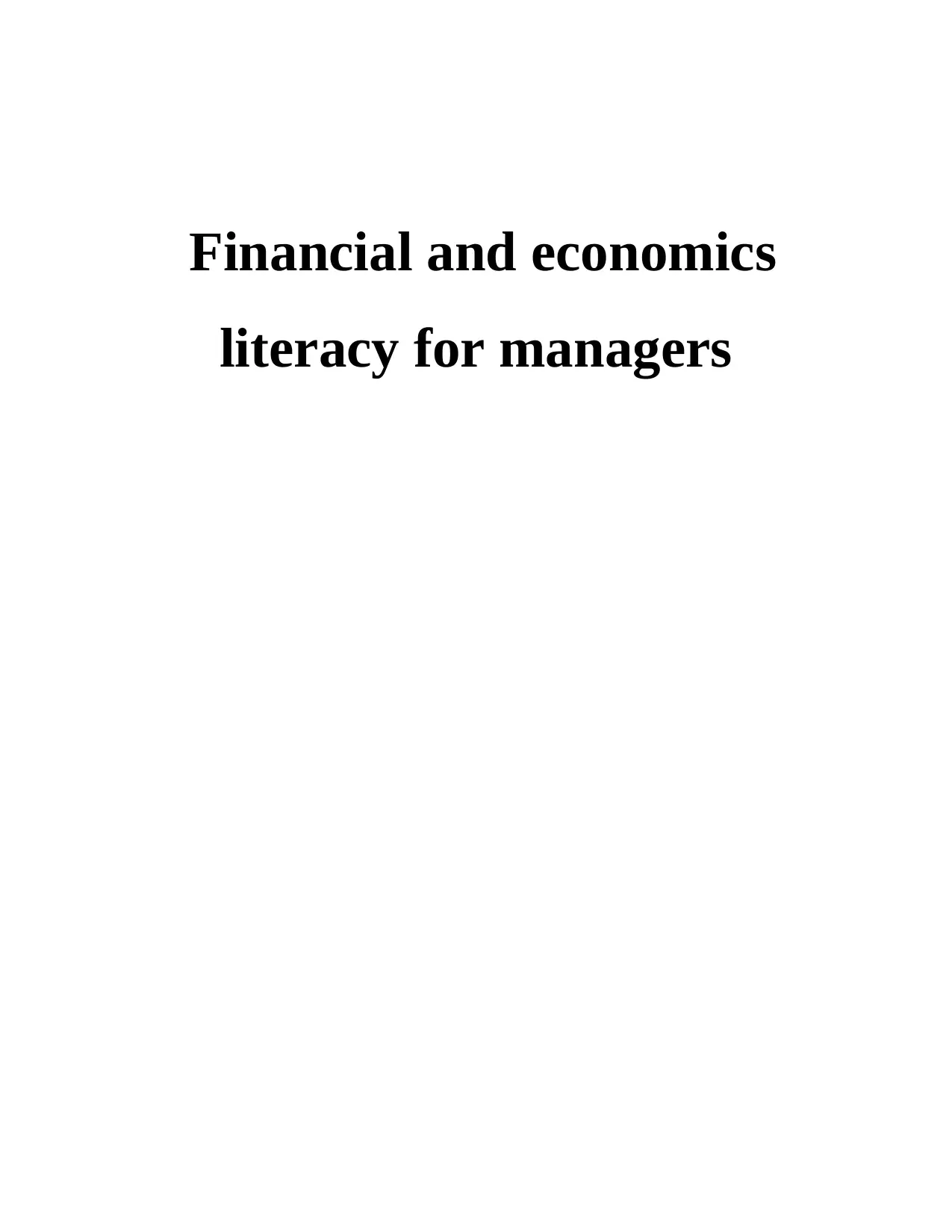
Financial and economics
literacy for managers
literacy for managers
Paraphrase This Document
Need a fresh take? Get an instant paraphrase of this document with our AI Paraphraser
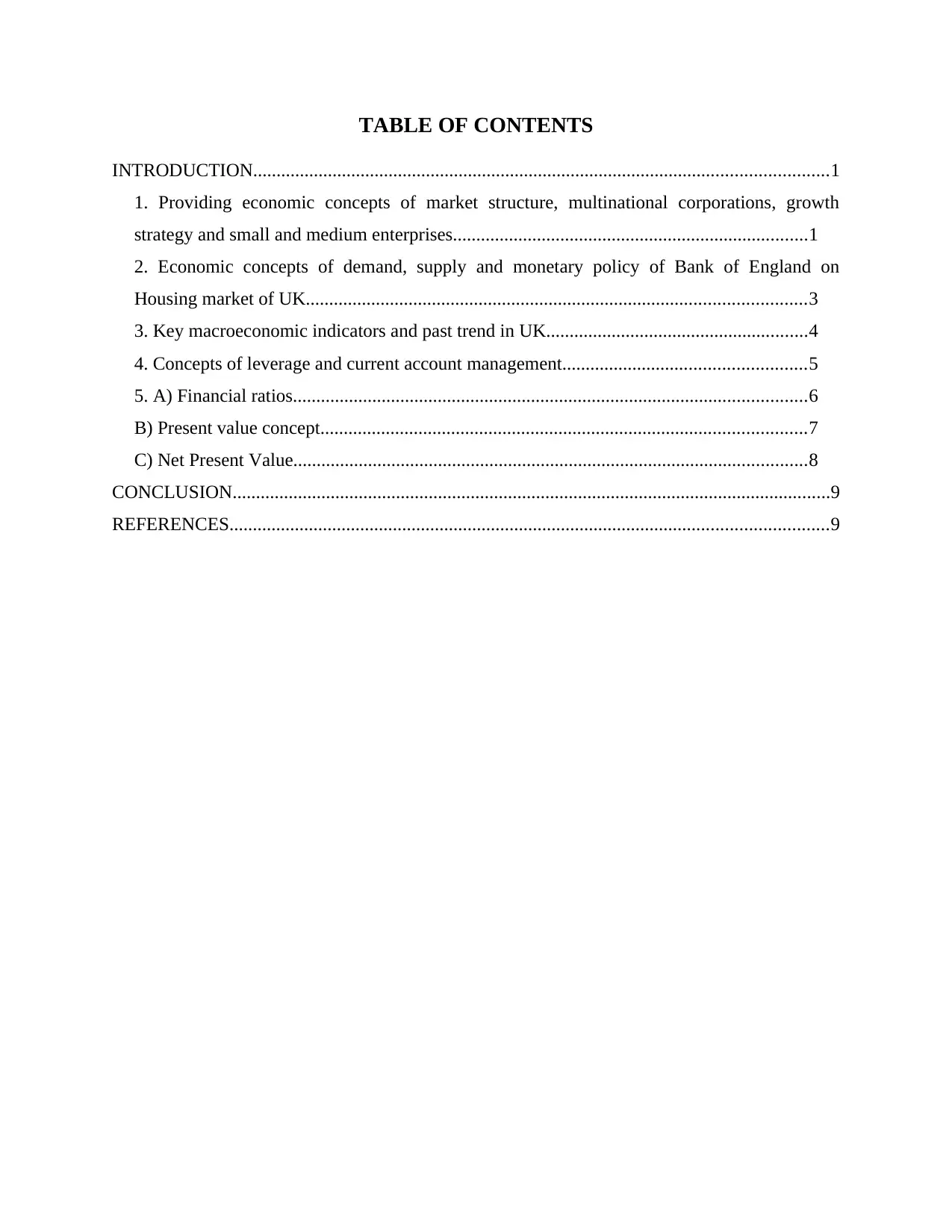
TABLE OF CONTENTS
INTRODUCTION...........................................................................................................................1
1. Providing economic concepts of market structure, multinational corporations, growth
strategy and small and medium enterprises............................................................................1
2. Economic concepts of demand, supply and monetary policy of Bank of England on
Housing market of UK...........................................................................................................3
3. Key macroeconomic indicators and past trend in UK........................................................4
4. Concepts of leverage and current account management....................................................5
5. A) Financial ratios..............................................................................................................6
B) Present value concept........................................................................................................7
C) Net Present Value..............................................................................................................8
CONCLUSION................................................................................................................................9
REFERENCES................................................................................................................................9
INTRODUCTION...........................................................................................................................1
1. Providing economic concepts of market structure, multinational corporations, growth
strategy and small and medium enterprises............................................................................1
2. Economic concepts of demand, supply and monetary policy of Bank of England on
Housing market of UK...........................................................................................................3
3. Key macroeconomic indicators and past trend in UK........................................................4
4. Concepts of leverage and current account management....................................................5
5. A) Financial ratios..............................................................................................................6
B) Present value concept........................................................................................................7
C) Net Present Value..............................................................................................................8
CONCLUSION................................................................................................................................9
REFERENCES................................................................................................................................9
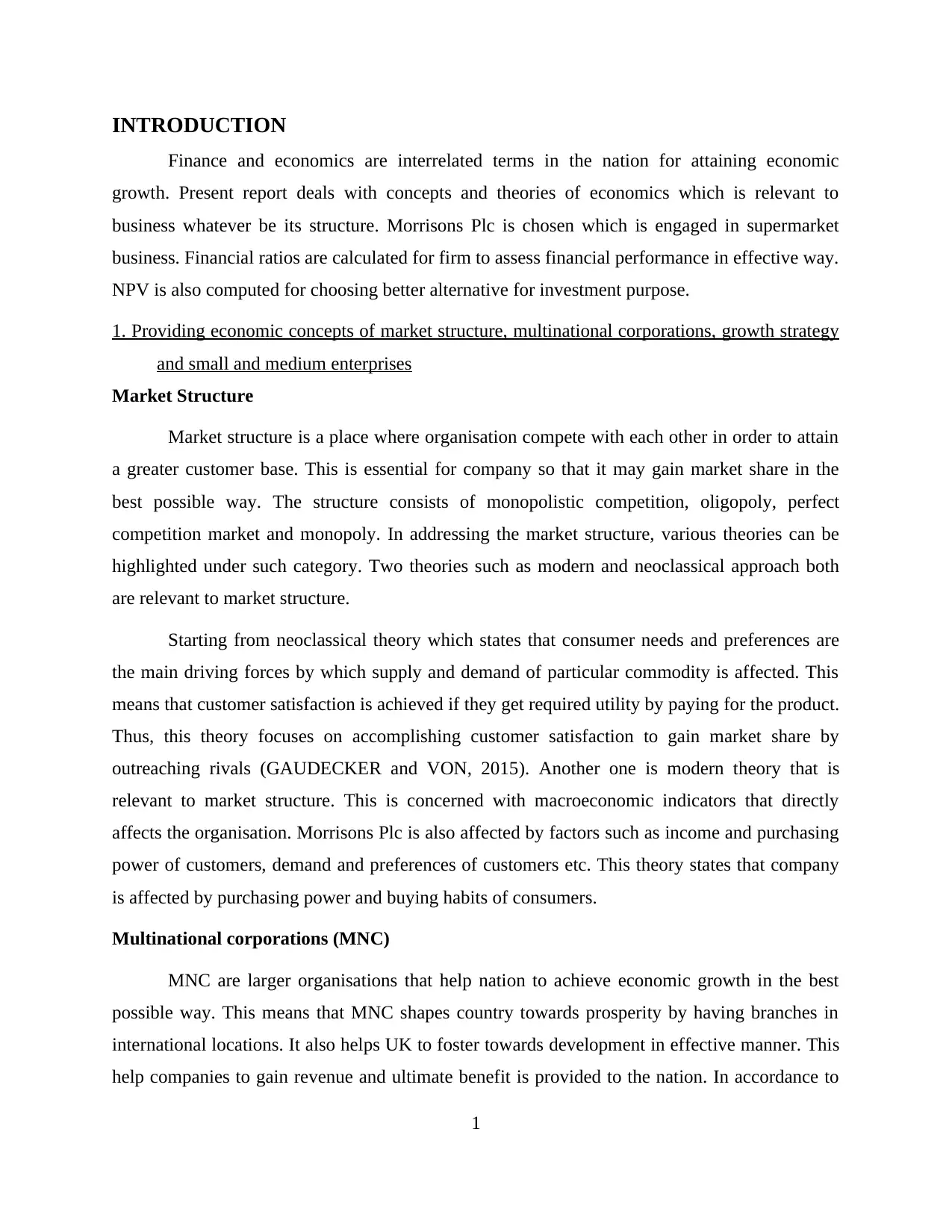
INTRODUCTION
Finance and economics are interrelated terms in the nation for attaining economic
growth. Present report deals with concepts and theories of economics which is relevant to
business whatever be its structure. Morrisons Plc is chosen which is engaged in supermarket
business. Financial ratios are calculated for firm to assess financial performance in effective way.
NPV is also computed for choosing better alternative for investment purpose.
1. Providing economic concepts of market structure, multinational corporations, growth strategy
and small and medium enterprises
Market Structure
Market structure is a place where organisation compete with each other in order to attain
a greater customer base. This is essential for company so that it may gain market share in the
best possible way. The structure consists of monopolistic competition, oligopoly, perfect
competition market and monopoly. In addressing the market structure, various theories can be
highlighted under such category. Two theories such as modern and neoclassical approach both
are relevant to market structure.
Starting from neoclassical theory which states that consumer needs and preferences are
the main driving forces by which supply and demand of particular commodity is affected. This
means that customer satisfaction is achieved if they get required utility by paying for the product.
Thus, this theory focuses on accomplishing customer satisfaction to gain market share by
outreaching rivals (GAUDECKER and VON, 2015). Another one is modern theory that is
relevant to market structure. This is concerned with macroeconomic indicators that directly
affects the organisation. Morrisons Plc is also affected by factors such as income and purchasing
power of customers, demand and preferences of customers etc. This theory states that company
is affected by purchasing power and buying habits of consumers.
Multinational corporations (MNC)
MNC are larger organisations that help nation to achieve economic growth in the best
possible way. This means that MNC shapes country towards prosperity by having branches in
international locations. It also helps UK to foster towards development in effective manner. This
help companies to gain revenue and ultimate benefit is provided to the nation. In accordance to
1
Finance and economics are interrelated terms in the nation for attaining economic
growth. Present report deals with concepts and theories of economics which is relevant to
business whatever be its structure. Morrisons Plc is chosen which is engaged in supermarket
business. Financial ratios are calculated for firm to assess financial performance in effective way.
NPV is also computed for choosing better alternative for investment purpose.
1. Providing economic concepts of market structure, multinational corporations, growth strategy
and small and medium enterprises
Market Structure
Market structure is a place where organisation compete with each other in order to attain
a greater customer base. This is essential for company so that it may gain market share in the
best possible way. The structure consists of monopolistic competition, oligopoly, perfect
competition market and monopoly. In addressing the market structure, various theories can be
highlighted under such category. Two theories such as modern and neoclassical approach both
are relevant to market structure.
Starting from neoclassical theory which states that consumer needs and preferences are
the main driving forces by which supply and demand of particular commodity is affected. This
means that customer satisfaction is achieved if they get required utility by paying for the product.
Thus, this theory focuses on accomplishing customer satisfaction to gain market share by
outreaching rivals (GAUDECKER and VON, 2015). Another one is modern theory that is
relevant to market structure. This is concerned with macroeconomic indicators that directly
affects the organisation. Morrisons Plc is also affected by factors such as income and purchasing
power of customers, demand and preferences of customers etc. This theory states that company
is affected by purchasing power and buying habits of consumers.
Multinational corporations (MNC)
MNC are larger organisations that help nation to achieve economic growth in the best
possible way. This means that MNC shapes country towards prosperity by having branches in
international locations. It also helps UK to foster towards development in effective manner. This
help companies to gain revenue and ultimate benefit is provided to the nation. In accordance to
1
⊘ This is a preview!⊘
Do you want full access?
Subscribe today to unlock all pages.

Trusted by 1+ million students worldwide
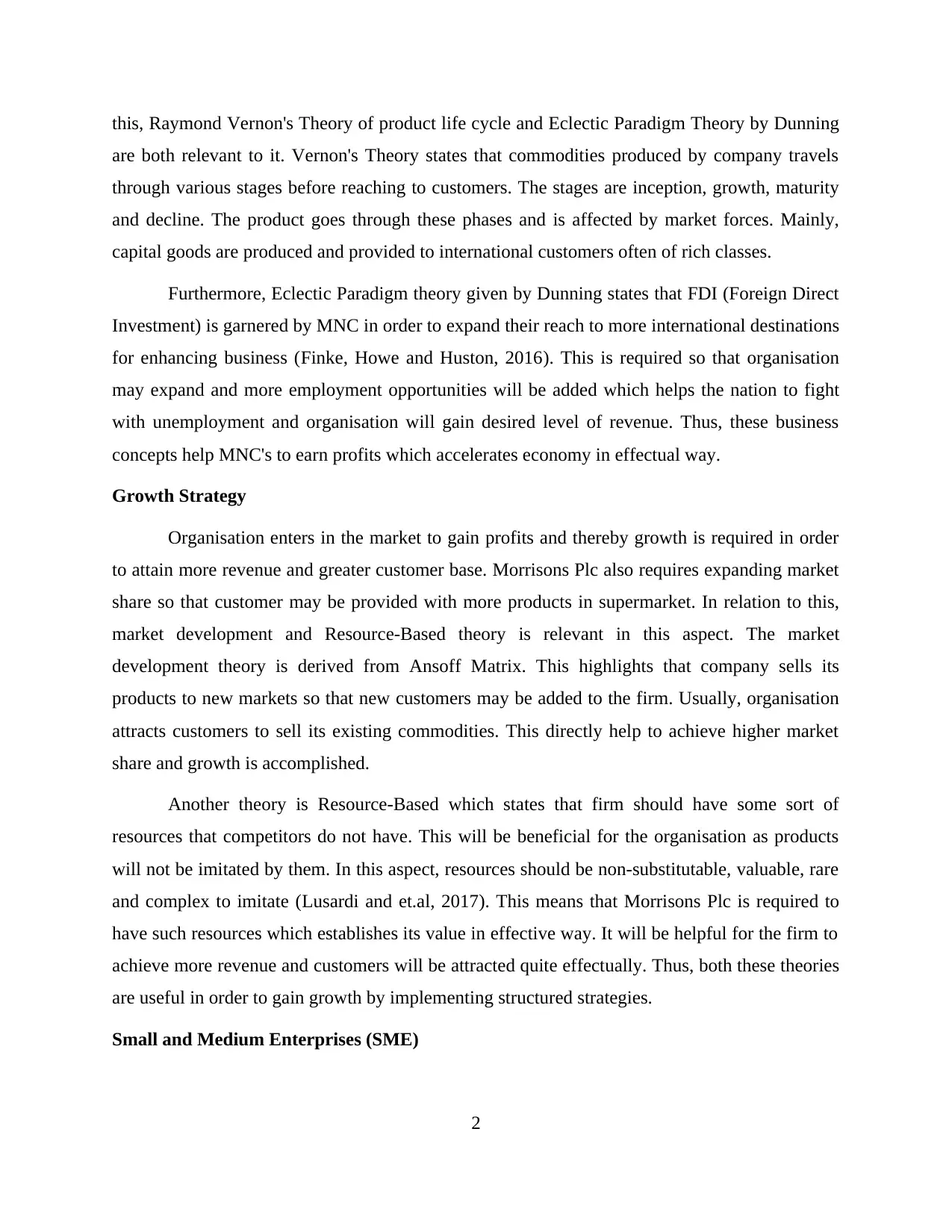
this, Raymond Vernon's Theory of product life cycle and Eclectic Paradigm Theory by Dunning
are both relevant to it. Vernon's Theory states that commodities produced by company travels
through various stages before reaching to customers. The stages are inception, growth, maturity
and decline. The product goes through these phases and is affected by market forces. Mainly,
capital goods are produced and provided to international customers often of rich classes.
Furthermore, Eclectic Paradigm theory given by Dunning states that FDI (Foreign Direct
Investment) is garnered by MNC in order to expand their reach to more international destinations
for enhancing business (Finke, Howe and Huston, 2016). This is required so that organisation
may expand and more employment opportunities will be added which helps the nation to fight
with unemployment and organisation will gain desired level of revenue. Thus, these business
concepts help MNC's to earn profits which accelerates economy in effectual way.
Growth Strategy
Organisation enters in the market to gain profits and thereby growth is required in order
to attain more revenue and greater customer base. Morrisons Plc also requires expanding market
share so that customer may be provided with more products in supermarket. In relation to this,
market development and Resource-Based theory is relevant in this aspect. The market
development theory is derived from Ansoff Matrix. This highlights that company sells its
products to new markets so that new customers may be added to the firm. Usually, organisation
attracts customers to sell its existing commodities. This directly help to achieve higher market
share and growth is accomplished.
Another theory is Resource-Based which states that firm should have some sort of
resources that competitors do not have. This will be beneficial for the organisation as products
will not be imitated by them. In this aspect, resources should be non-substitutable, valuable, rare
and complex to imitate (Lusardi and et.al, 2017). This means that Morrisons Plc is required to
have such resources which establishes its value in effective way. It will be helpful for the firm to
achieve more revenue and customers will be attracted quite effectually. Thus, both these theories
are useful in order to gain growth by implementing structured strategies.
Small and Medium Enterprises (SME)
2
are both relevant to it. Vernon's Theory states that commodities produced by company travels
through various stages before reaching to customers. The stages are inception, growth, maturity
and decline. The product goes through these phases and is affected by market forces. Mainly,
capital goods are produced and provided to international customers often of rich classes.
Furthermore, Eclectic Paradigm theory given by Dunning states that FDI (Foreign Direct
Investment) is garnered by MNC in order to expand their reach to more international destinations
for enhancing business (Finke, Howe and Huston, 2016). This is required so that organisation
may expand and more employment opportunities will be added which helps the nation to fight
with unemployment and organisation will gain desired level of revenue. Thus, these business
concepts help MNC's to earn profits which accelerates economy in effectual way.
Growth Strategy
Organisation enters in the market to gain profits and thereby growth is required in order
to attain more revenue and greater customer base. Morrisons Plc also requires expanding market
share so that customer may be provided with more products in supermarket. In relation to this,
market development and Resource-Based theory is relevant in this aspect. The market
development theory is derived from Ansoff Matrix. This highlights that company sells its
products to new markets so that new customers may be added to the firm. Usually, organisation
attracts customers to sell its existing commodities. This directly help to achieve higher market
share and growth is accomplished.
Another theory is Resource-Based which states that firm should have some sort of
resources that competitors do not have. This will be beneficial for the organisation as products
will not be imitated by them. In this aspect, resources should be non-substitutable, valuable, rare
and complex to imitate (Lusardi and et.al, 2017). This means that Morrisons Plc is required to
have such resources which establishes its value in effective way. It will be helpful for the firm to
achieve more revenue and customers will be attracted quite effectually. Thus, both these theories
are useful in order to gain growth by implementing structured strategies.
Small and Medium Enterprises (SME)
2
Paraphrase This Document
Need a fresh take? Get an instant paraphrase of this document with our AI Paraphraser
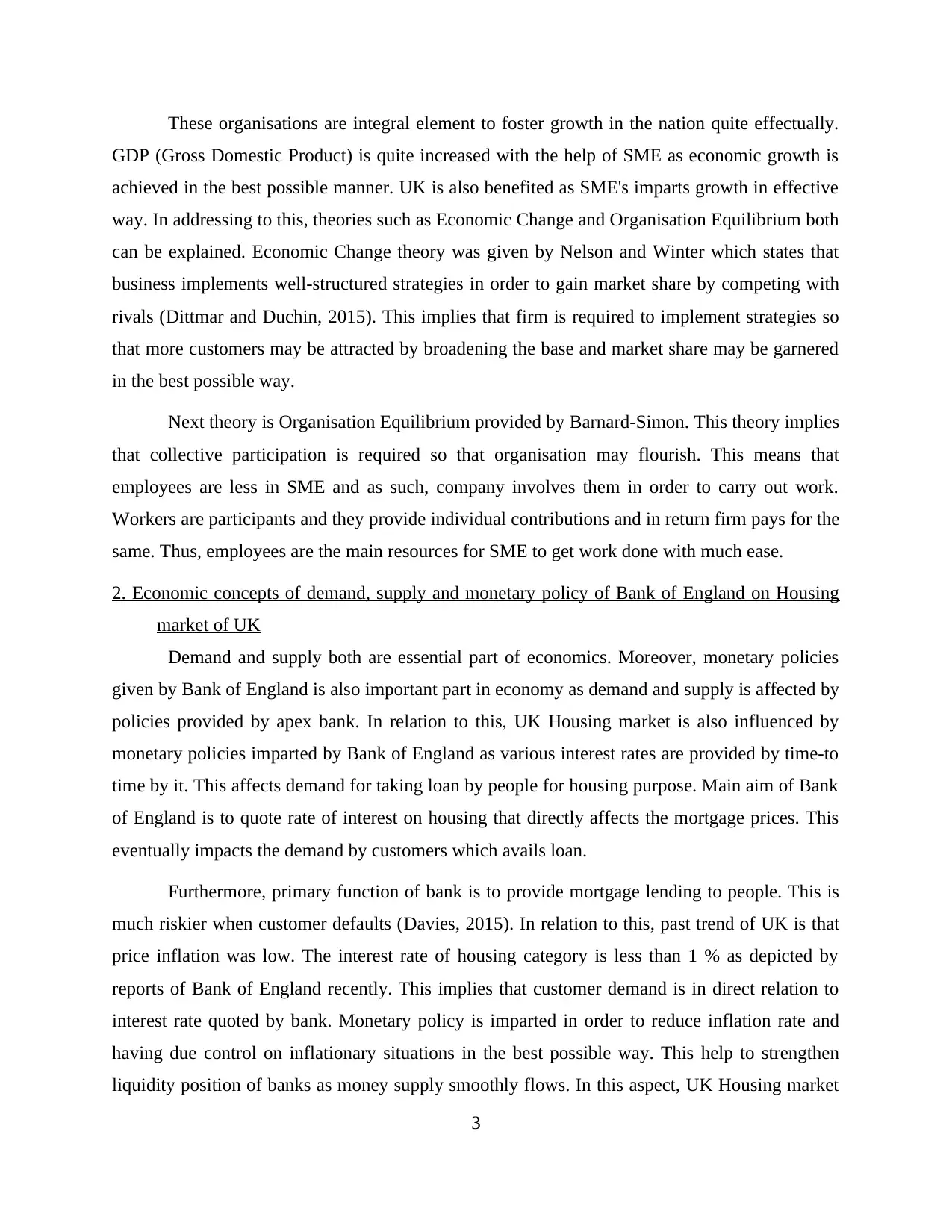
These organisations are integral element to foster growth in the nation quite effectually.
GDP (Gross Domestic Product) is quite increased with the help of SME as economic growth is
achieved in the best possible manner. UK is also benefited as SME's imparts growth in effective
way. In addressing to this, theories such as Economic Change and Organisation Equilibrium both
can be explained. Economic Change theory was given by Nelson and Winter which states that
business implements well-structured strategies in order to gain market share by competing with
rivals (Dittmar and Duchin, 2015). This implies that firm is required to implement strategies so
that more customers may be attracted by broadening the base and market share may be garnered
in the best possible way.
Next theory is Organisation Equilibrium provided by Barnard-Simon. This theory implies
that collective participation is required so that organisation may flourish. This means that
employees are less in SME and as such, company involves them in order to carry out work.
Workers are participants and they provide individual contributions and in return firm pays for the
same. Thus, employees are the main resources for SME to get work done with much ease.
2. Economic concepts of demand, supply and monetary policy of Bank of England on Housing
market of UK
Demand and supply both are essential part of economics. Moreover, monetary policies
given by Bank of England is also important part in economy as demand and supply is affected by
policies provided by apex bank. In relation to this, UK Housing market is also influenced by
monetary policies imparted by Bank of England as various interest rates are provided by time-to
time by it. This affects demand for taking loan by people for housing purpose. Main aim of Bank
of England is to quote rate of interest on housing that directly affects the mortgage prices. This
eventually impacts the demand by customers which avails loan.
Furthermore, primary function of bank is to provide mortgage lending to people. This is
much riskier when customer defaults (Davies, 2015). In relation to this, past trend of UK is that
price inflation was low. The interest rate of housing category is less than 1 % as depicted by
reports of Bank of England recently. This implies that customer demand is in direct relation to
interest rate quoted by bank. Monetary policy is imparted in order to reduce inflation rate and
having due control on inflationary situations in the best possible way. This help to strengthen
liquidity position of banks as money supply smoothly flows. In this aspect, UK Housing market
3
GDP (Gross Domestic Product) is quite increased with the help of SME as economic growth is
achieved in the best possible manner. UK is also benefited as SME's imparts growth in effective
way. In addressing to this, theories such as Economic Change and Organisation Equilibrium both
can be explained. Economic Change theory was given by Nelson and Winter which states that
business implements well-structured strategies in order to gain market share by competing with
rivals (Dittmar and Duchin, 2015). This implies that firm is required to implement strategies so
that more customers may be attracted by broadening the base and market share may be garnered
in the best possible way.
Next theory is Organisation Equilibrium provided by Barnard-Simon. This theory implies
that collective participation is required so that organisation may flourish. This means that
employees are less in SME and as such, company involves them in order to carry out work.
Workers are participants and they provide individual contributions and in return firm pays for the
same. Thus, employees are the main resources for SME to get work done with much ease.
2. Economic concepts of demand, supply and monetary policy of Bank of England on Housing
market of UK
Demand and supply both are essential part of economics. Moreover, monetary policies
given by Bank of England is also important part in economy as demand and supply is affected by
policies provided by apex bank. In relation to this, UK Housing market is also influenced by
monetary policies imparted by Bank of England as various interest rates are provided by time-to
time by it. This affects demand for taking loan by people for housing purpose. Main aim of Bank
of England is to quote rate of interest on housing that directly affects the mortgage prices. This
eventually impacts the demand by customers which avails loan.
Furthermore, primary function of bank is to provide mortgage lending to people. This is
much riskier when customer defaults (Davies, 2015). In relation to this, past trend of UK is that
price inflation was low. The interest rate of housing category is less than 1 % as depicted by
reports of Bank of England recently. This implies that customer demand is in direct relation to
interest rate quoted by bank. Monetary policy is imparted in order to reduce inflation rate and
having due control on inflationary situations in the best possible way. This help to strengthen
liquidity position of banks as money supply smoothly flows. In this aspect, UK Housing market
3
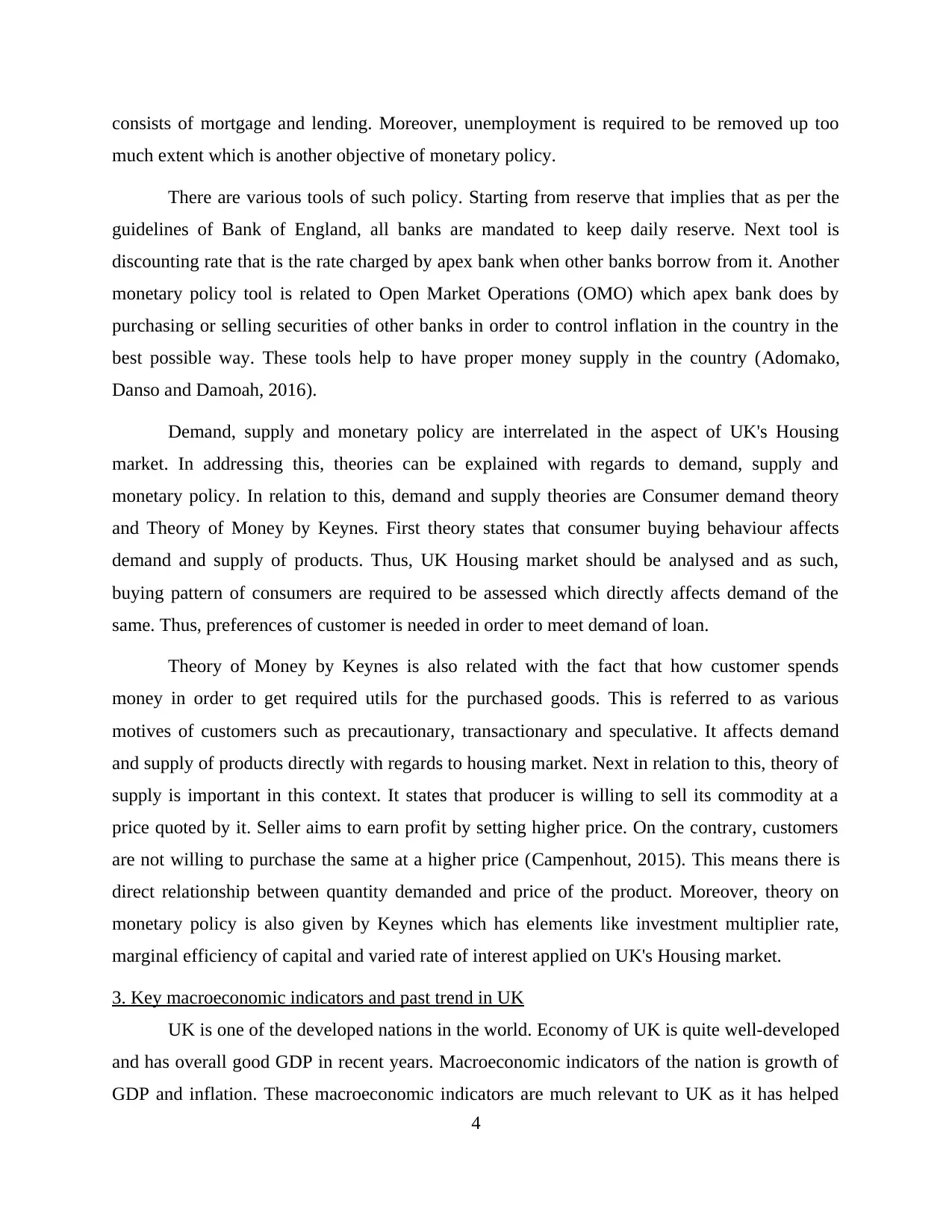
consists of mortgage and lending. Moreover, unemployment is required to be removed up too
much extent which is another objective of monetary policy.
There are various tools of such policy. Starting from reserve that implies that as per the
guidelines of Bank of England, all banks are mandated to keep daily reserve. Next tool is
discounting rate that is the rate charged by apex bank when other banks borrow from it. Another
monetary policy tool is related to Open Market Operations (OMO) which apex bank does by
purchasing or selling securities of other banks in order to control inflation in the country in the
best possible way. These tools help to have proper money supply in the country (Adomako,
Danso and Damoah, 2016).
Demand, supply and monetary policy are interrelated in the aspect of UK's Housing
market. In addressing this, theories can be explained with regards to demand, supply and
monetary policy. In relation to this, demand and supply theories are Consumer demand theory
and Theory of Money by Keynes. First theory states that consumer buying behaviour affects
demand and supply of products. Thus, UK Housing market should be analysed and as such,
buying pattern of consumers are required to be assessed which directly affects demand of the
same. Thus, preferences of customer is needed in order to meet demand of loan.
Theory of Money by Keynes is also related with the fact that how customer spends
money in order to get required utils for the purchased goods. This is referred to as various
motives of customers such as precautionary, transactionary and speculative. It affects demand
and supply of products directly with regards to housing market. Next in relation to this, theory of
supply is important in this context. It states that producer is willing to sell its commodity at a
price quoted by it. Seller aims to earn profit by setting higher price. On the contrary, customers
are not willing to purchase the same at a higher price (Campenhout, 2015). This means there is
direct relationship between quantity demanded and price of the product. Moreover, theory on
monetary policy is also given by Keynes which has elements like investment multiplier rate,
marginal efficiency of capital and varied rate of interest applied on UK's Housing market.
3. Key macroeconomic indicators and past trend in UK
UK is one of the developed nations in the world. Economy of UK is quite well-developed
and has overall good GDP in recent years. Macroeconomic indicators of the nation is growth of
GDP and inflation. These macroeconomic indicators are much relevant to UK as it has helped
4
much extent which is another objective of monetary policy.
There are various tools of such policy. Starting from reserve that implies that as per the
guidelines of Bank of England, all banks are mandated to keep daily reserve. Next tool is
discounting rate that is the rate charged by apex bank when other banks borrow from it. Another
monetary policy tool is related to Open Market Operations (OMO) which apex bank does by
purchasing or selling securities of other banks in order to control inflation in the country in the
best possible way. These tools help to have proper money supply in the country (Adomako,
Danso and Damoah, 2016).
Demand, supply and monetary policy are interrelated in the aspect of UK's Housing
market. In addressing this, theories can be explained with regards to demand, supply and
monetary policy. In relation to this, demand and supply theories are Consumer demand theory
and Theory of Money by Keynes. First theory states that consumer buying behaviour affects
demand and supply of products. Thus, UK Housing market should be analysed and as such,
buying pattern of consumers are required to be assessed which directly affects demand of the
same. Thus, preferences of customer is needed in order to meet demand of loan.
Theory of Money by Keynes is also related with the fact that how customer spends
money in order to get required utils for the purchased goods. This is referred to as various
motives of customers such as precautionary, transactionary and speculative. It affects demand
and supply of products directly with regards to housing market. Next in relation to this, theory of
supply is important in this context. It states that producer is willing to sell its commodity at a
price quoted by it. Seller aims to earn profit by setting higher price. On the contrary, customers
are not willing to purchase the same at a higher price (Campenhout, 2015). This means there is
direct relationship between quantity demanded and price of the product. Moreover, theory on
monetary policy is also given by Keynes which has elements like investment multiplier rate,
marginal efficiency of capital and varied rate of interest applied on UK's Housing market.
3. Key macroeconomic indicators and past trend in UK
UK is one of the developed nations in the world. Economy of UK is quite well-developed
and has overall good GDP in recent years. Macroeconomic indicators of the nation is growth of
GDP and inflation. These macroeconomic indicators are much relevant to UK as it has helped
4
⊘ This is a preview!⊘
Do you want full access?
Subscribe today to unlock all pages.

Trusted by 1+ million students worldwide
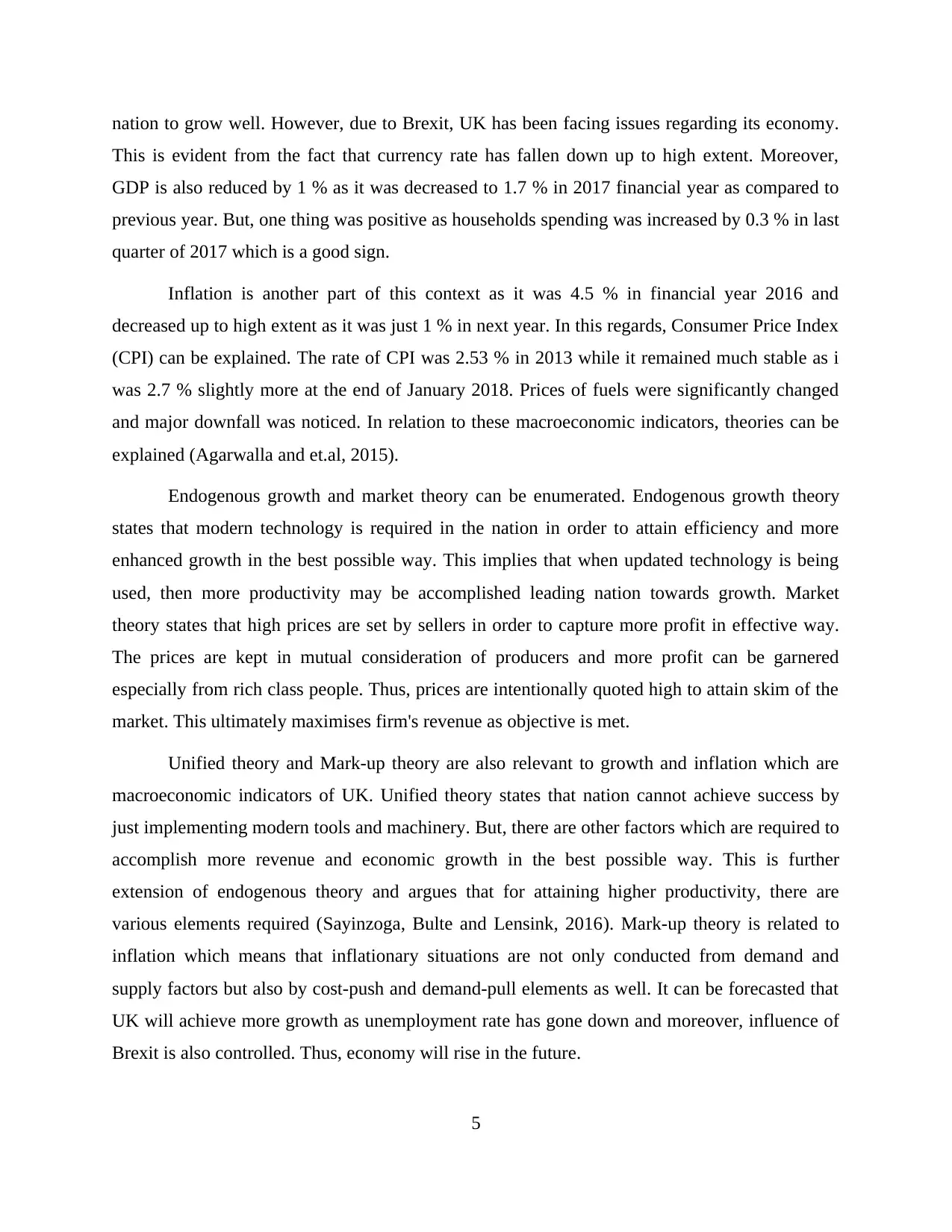
nation to grow well. However, due to Brexit, UK has been facing issues regarding its economy.
This is evident from the fact that currency rate has fallen down up to high extent. Moreover,
GDP is also reduced by 1 % as it was decreased to 1.7 % in 2017 financial year as compared to
previous year. But, one thing was positive as households spending was increased by 0.3 % in last
quarter of 2017 which is a good sign.
Inflation is another part of this context as it was 4.5 % in financial year 2016 and
decreased up to high extent as it was just 1 % in next year. In this regards, Consumer Price Index
(CPI) can be explained. The rate of CPI was 2.53 % in 2013 while it remained much stable as i
was 2.7 % slightly more at the end of January 2018. Prices of fuels were significantly changed
and major downfall was noticed. In relation to these macroeconomic indicators, theories can be
explained (Agarwalla and et.al, 2015).
Endogenous growth and market theory can be enumerated. Endogenous growth theory
states that modern technology is required in the nation in order to attain efficiency and more
enhanced growth in the best possible way. This implies that when updated technology is being
used, then more productivity may be accomplished leading nation towards growth. Market
theory states that high prices are set by sellers in order to capture more profit in effective way.
The prices are kept in mutual consideration of producers and more profit can be garnered
especially from rich class people. Thus, prices are intentionally quoted high to attain skim of the
market. This ultimately maximises firm's revenue as objective is met.
Unified theory and Mark-up theory are also relevant to growth and inflation which are
macroeconomic indicators of UK. Unified theory states that nation cannot achieve success by
just implementing modern tools and machinery. But, there are other factors which are required to
accomplish more revenue and economic growth in the best possible way. This is further
extension of endogenous theory and argues that for attaining higher productivity, there are
various elements required (Sayinzoga, Bulte and Lensink, 2016). Mark-up theory is related to
inflation which means that inflationary situations are not only conducted from demand and
supply factors but also by cost-push and demand-pull elements as well. It can be forecasted that
UK will achieve more growth as unemployment rate has gone down and moreover, influence of
Brexit is also controlled. Thus, economy will rise in the future.
5
This is evident from the fact that currency rate has fallen down up to high extent. Moreover,
GDP is also reduced by 1 % as it was decreased to 1.7 % in 2017 financial year as compared to
previous year. But, one thing was positive as households spending was increased by 0.3 % in last
quarter of 2017 which is a good sign.
Inflation is another part of this context as it was 4.5 % in financial year 2016 and
decreased up to high extent as it was just 1 % in next year. In this regards, Consumer Price Index
(CPI) can be explained. The rate of CPI was 2.53 % in 2013 while it remained much stable as i
was 2.7 % slightly more at the end of January 2018. Prices of fuels were significantly changed
and major downfall was noticed. In relation to these macroeconomic indicators, theories can be
explained (Agarwalla and et.al, 2015).
Endogenous growth and market theory can be enumerated. Endogenous growth theory
states that modern technology is required in the nation in order to attain efficiency and more
enhanced growth in the best possible way. This implies that when updated technology is being
used, then more productivity may be accomplished leading nation towards growth. Market
theory states that high prices are set by sellers in order to capture more profit in effective way.
The prices are kept in mutual consideration of producers and more profit can be garnered
especially from rich class people. Thus, prices are intentionally quoted high to attain skim of the
market. This ultimately maximises firm's revenue as objective is met.
Unified theory and Mark-up theory are also relevant to growth and inflation which are
macroeconomic indicators of UK. Unified theory states that nation cannot achieve success by
just implementing modern tools and machinery. But, there are other factors which are required to
accomplish more revenue and economic growth in the best possible way. This is further
extension of endogenous theory and argues that for attaining higher productivity, there are
various elements required (Sayinzoga, Bulte and Lensink, 2016). Mark-up theory is related to
inflation which means that inflationary situations are not only conducted from demand and
supply factors but also by cost-push and demand-pull elements as well. It can be forecasted that
UK will achieve more growth as unemployment rate has gone down and moreover, influence of
Brexit is also controlled. Thus, economy will rise in the future.
5
Paraphrase This Document
Need a fresh take? Get an instant paraphrase of this document with our AI Paraphraser
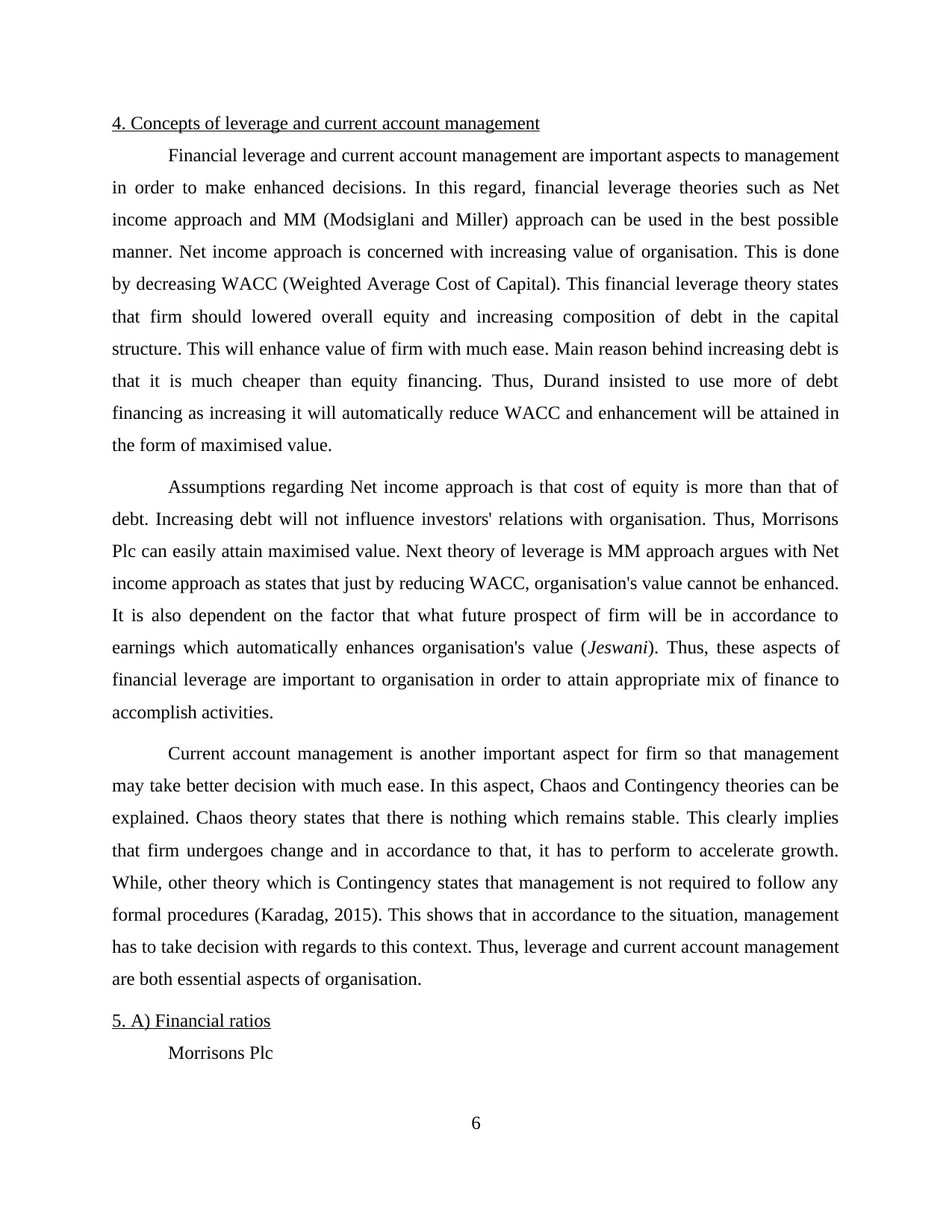
4. Concepts of leverage and current account management
Financial leverage and current account management are important aspects to management
in order to make enhanced decisions. In this regard, financial leverage theories such as Net
income approach and MM (Modsiglani and Miller) approach can be used in the best possible
manner. Net income approach is concerned with increasing value of organisation. This is done
by decreasing WACC (Weighted Average Cost of Capital). This financial leverage theory states
that firm should lowered overall equity and increasing composition of debt in the capital
structure. This will enhance value of firm with much ease. Main reason behind increasing debt is
that it is much cheaper than equity financing. Thus, Durand insisted to use more of debt
financing as increasing it will automatically reduce WACC and enhancement will be attained in
the form of maximised value.
Assumptions regarding Net income approach is that cost of equity is more than that of
debt. Increasing debt will not influence investors' relations with organisation. Thus, Morrisons
Plc can easily attain maximised value. Next theory of leverage is MM approach argues with Net
income approach as states that just by reducing WACC, organisation's value cannot be enhanced.
It is also dependent on the factor that what future prospect of firm will be in accordance to
earnings which automatically enhances organisation's value (Jeswani). Thus, these aspects of
financial leverage are important to organisation in order to attain appropriate mix of finance to
accomplish activities.
Current account management is another important aspect for firm so that management
may take better decision with much ease. In this aspect, Chaos and Contingency theories can be
explained. Chaos theory states that there is nothing which remains stable. This clearly implies
that firm undergoes change and in accordance to that, it has to perform to accelerate growth.
While, other theory which is Contingency states that management is not required to follow any
formal procedures (Karadag, 2015). This shows that in accordance to the situation, management
has to take decision with regards to this context. Thus, leverage and current account management
are both essential aspects of organisation.
5. A) Financial ratios
Morrisons Plc
6
Financial leverage and current account management are important aspects to management
in order to make enhanced decisions. In this regard, financial leverage theories such as Net
income approach and MM (Modsiglani and Miller) approach can be used in the best possible
manner. Net income approach is concerned with increasing value of organisation. This is done
by decreasing WACC (Weighted Average Cost of Capital). This financial leverage theory states
that firm should lowered overall equity and increasing composition of debt in the capital
structure. This will enhance value of firm with much ease. Main reason behind increasing debt is
that it is much cheaper than equity financing. Thus, Durand insisted to use more of debt
financing as increasing it will automatically reduce WACC and enhancement will be attained in
the form of maximised value.
Assumptions regarding Net income approach is that cost of equity is more than that of
debt. Increasing debt will not influence investors' relations with organisation. Thus, Morrisons
Plc can easily attain maximised value. Next theory of leverage is MM approach argues with Net
income approach as states that just by reducing WACC, organisation's value cannot be enhanced.
It is also dependent on the factor that what future prospect of firm will be in accordance to
earnings which automatically enhances organisation's value (Jeswani). Thus, these aspects of
financial leverage are important to organisation in order to attain appropriate mix of finance to
accomplish activities.
Current account management is another important aspect for firm so that management
may take better decision with much ease. In this aspect, Chaos and Contingency theories can be
explained. Chaos theory states that there is nothing which remains stable. This clearly implies
that firm undergoes change and in accordance to that, it has to perform to accelerate growth.
While, other theory which is Contingency states that management is not required to follow any
formal procedures (Karadag, 2015). This shows that in accordance to the situation, management
has to take decision with regards to this context. Thus, leverage and current account management
are both essential aspects of organisation.
5. A) Financial ratios
Morrisons Plc
6
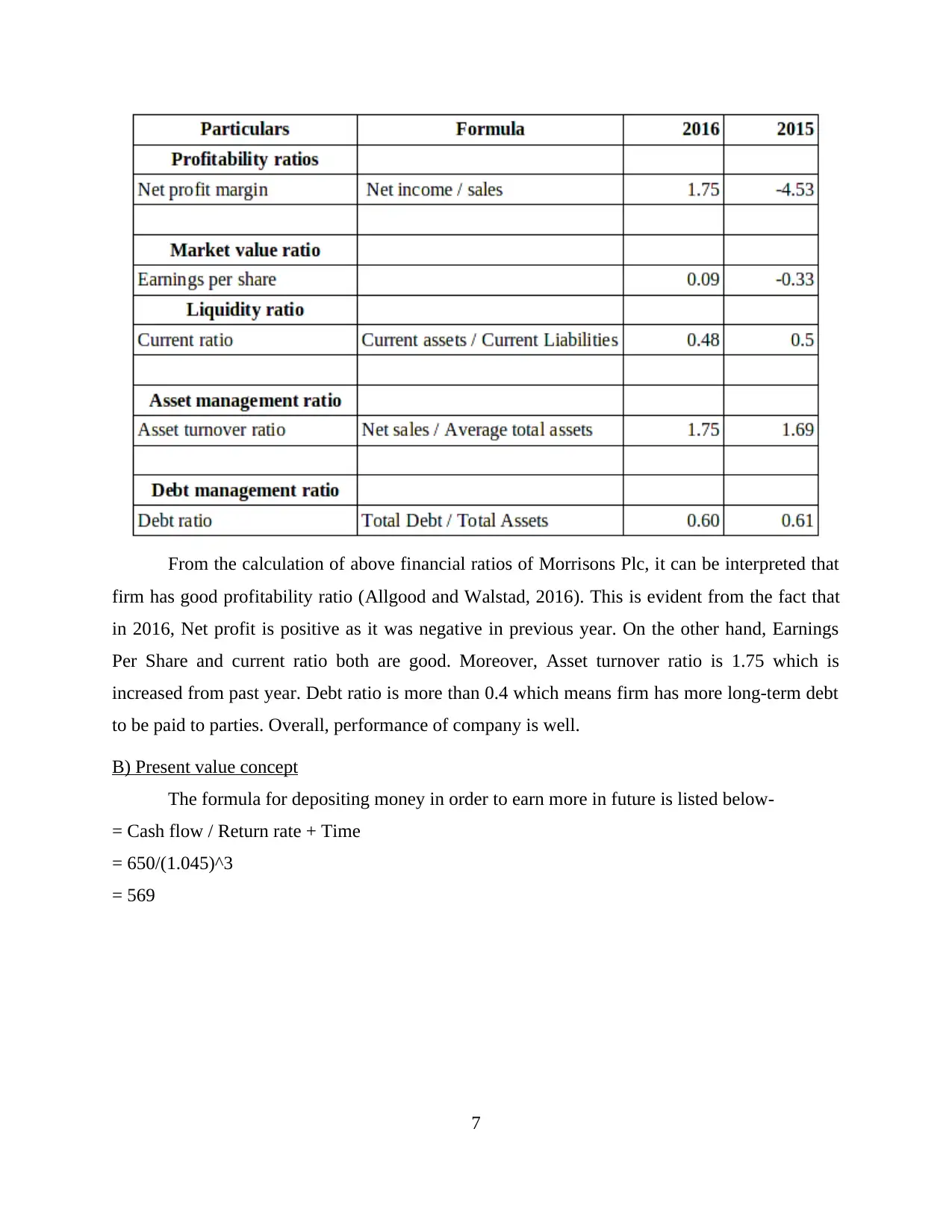
From the calculation of above financial ratios of Morrisons Plc, it can be interpreted that
firm has good profitability ratio (Allgood and Walstad, 2016). This is evident from the fact that
in 2016, Net profit is positive as it was negative in previous year. On the other hand, Earnings
Per Share and current ratio both are good. Moreover, Asset turnover ratio is 1.75 which is
increased from past year. Debt ratio is more than 0.4 which means firm has more long-term debt
to be paid to parties. Overall, performance of company is well.
B) Present value concept
The formula for depositing money in order to earn more in future is listed below-
= Cash flow / Return rate + Time
= 650/(1.045)^3
= 569
7
firm has good profitability ratio (Allgood and Walstad, 2016). This is evident from the fact that
in 2016, Net profit is positive as it was negative in previous year. On the other hand, Earnings
Per Share and current ratio both are good. Moreover, Asset turnover ratio is 1.75 which is
increased from past year. Debt ratio is more than 0.4 which means firm has more long-term debt
to be paid to parties. Overall, performance of company is well.
B) Present value concept
The formula for depositing money in order to earn more in future is listed below-
= Cash flow / Return rate + Time
= 650/(1.045)^3
= 569
7
⊘ This is a preview!⊘
Do you want full access?
Subscribe today to unlock all pages.

Trusted by 1+ million students worldwide
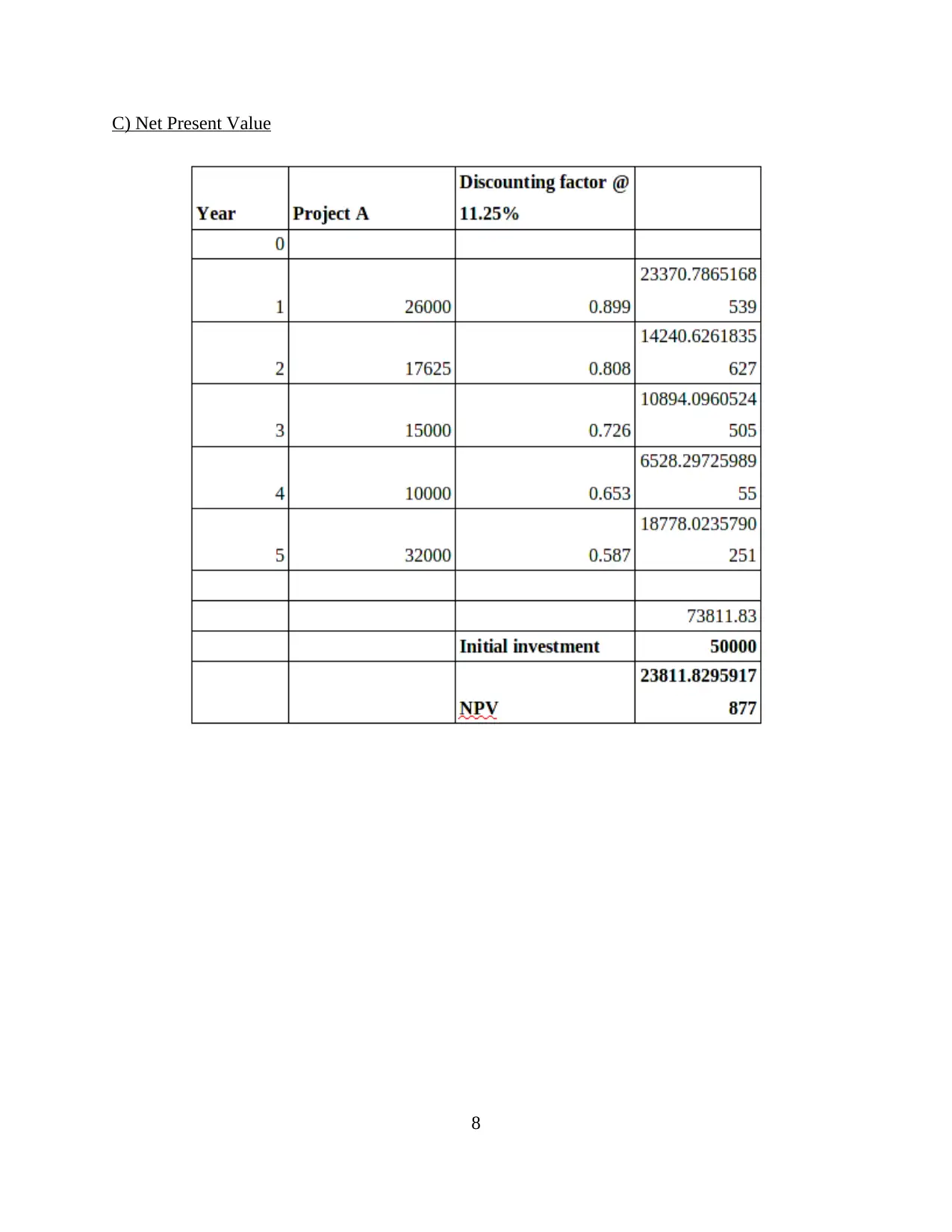
C) Net Present Value
8
8
Paraphrase This Document
Need a fresh take? Get an instant paraphrase of this document with our AI Paraphraser
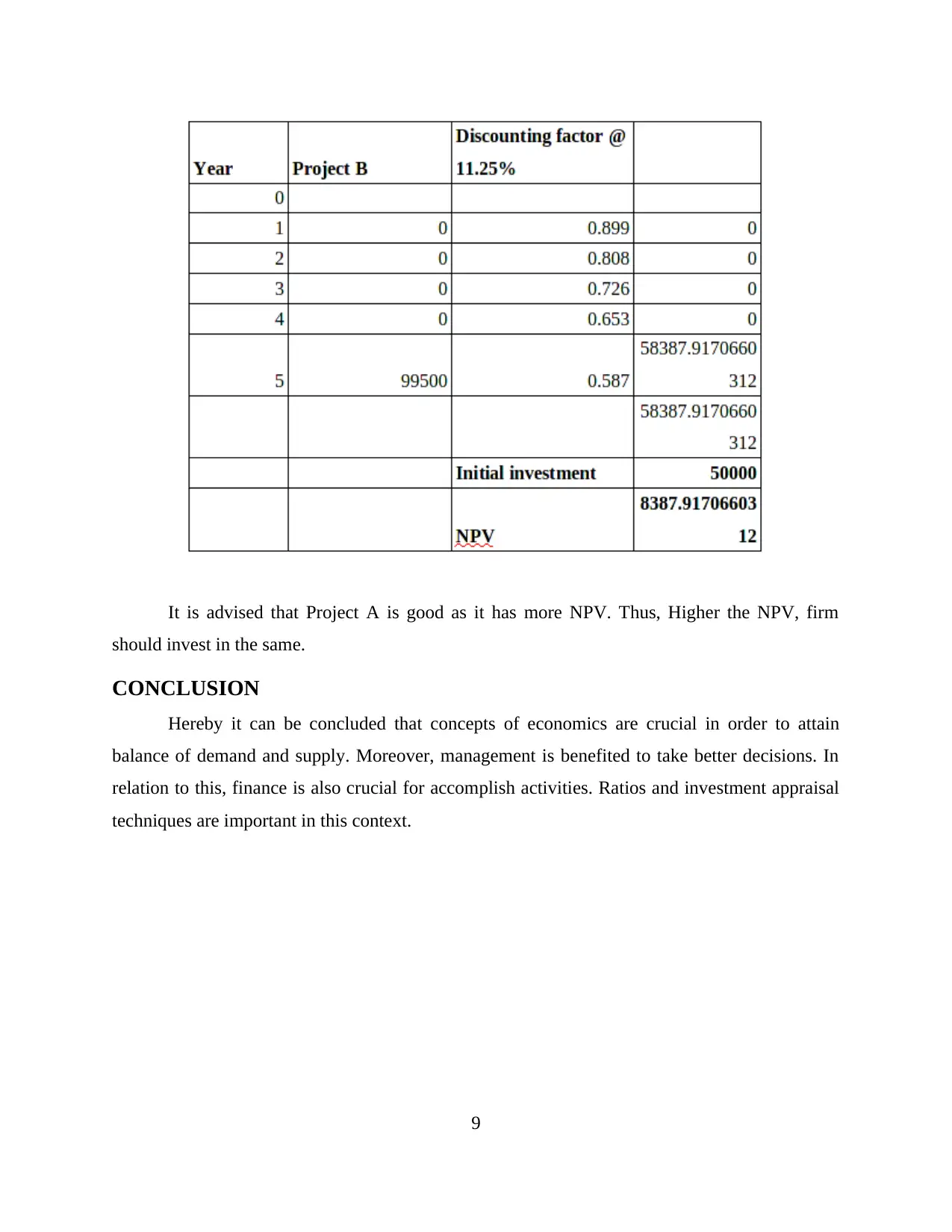
It is advised that Project A is good as it has more NPV. Thus, Higher the NPV, firm
should invest in the same.
CONCLUSION
Hereby it can be concluded that concepts of economics are crucial in order to attain
balance of demand and supply. Moreover, management is benefited to take better decisions. In
relation to this, finance is also crucial for accomplish activities. Ratios and investment appraisal
techniques are important in this context.
9
should invest in the same.
CONCLUSION
Hereby it can be concluded that concepts of economics are crucial in order to attain
balance of demand and supply. Moreover, management is benefited to take better decisions. In
relation to this, finance is also crucial for accomplish activities. Ratios and investment appraisal
techniques are important in this context.
9
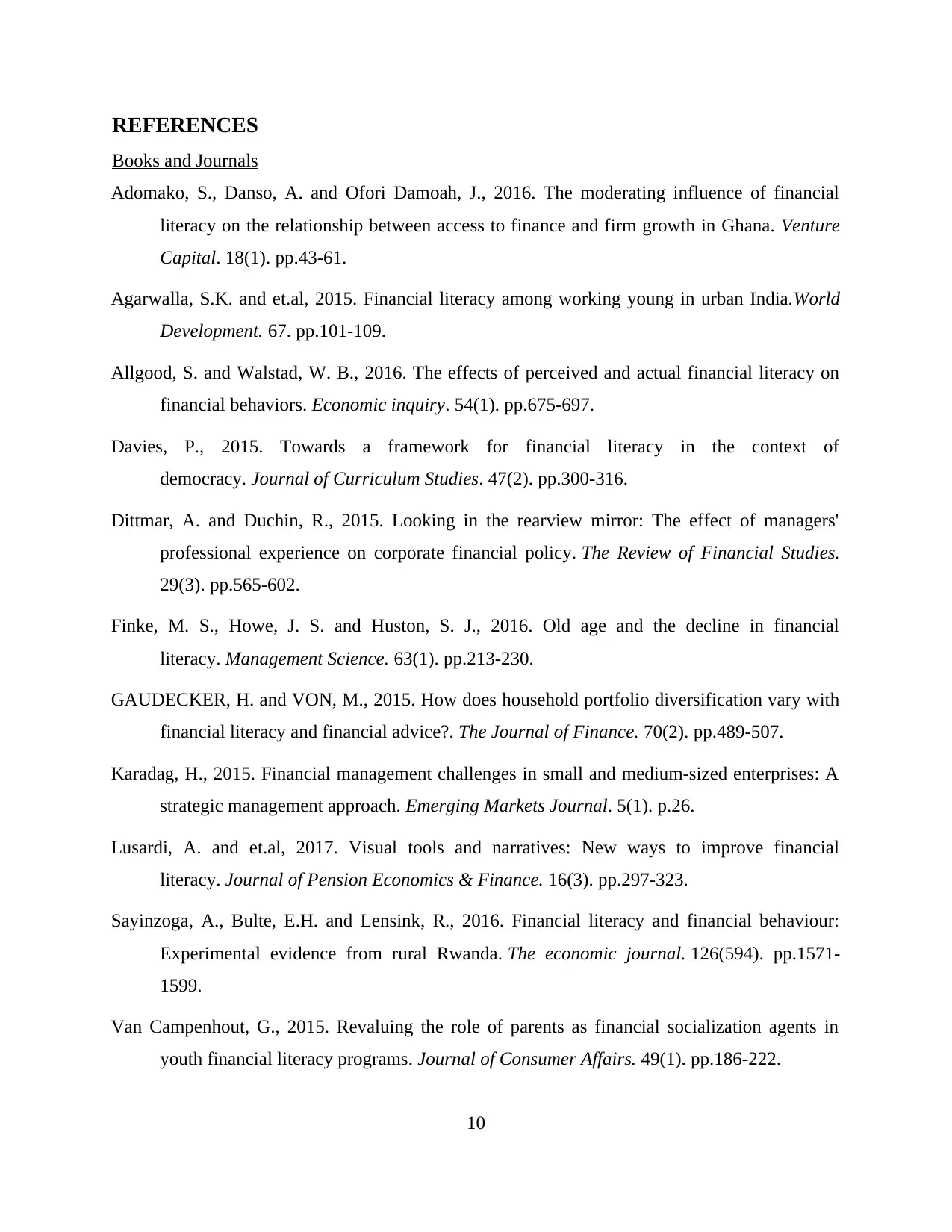
REFERENCES
Books and Journals
Adomako, S., Danso, A. and Ofori Damoah, J., 2016. The moderating influence of financial
literacy on the relationship between access to finance and firm growth in Ghana. Venture
Capital. 18(1). pp.43-61.
Agarwalla, S.K. and et.al, 2015. Financial literacy among working young in urban India.World
Development. 67. pp.101-109.
Allgood, S. and Walstad, W. B., 2016. The effects of perceived and actual financial literacy on
financial behaviors. Economic inquiry. 54(1). pp.675-697.
Davies, P., 2015. Towards a framework for financial literacy in the context of
democracy. Journal of Curriculum Studies. 47(2). pp.300-316.
Dittmar, A. and Duchin, R., 2015. Looking in the rearview mirror: The effect of managers'
professional experience on corporate financial policy. The Review of Financial Studies.
29(3). pp.565-602.
Finke, M. S., Howe, J. S. and Huston, S. J., 2016. Old age and the decline in financial
literacy. Management Science. 63(1). pp.213-230.
GAUDECKER, H. and VON, M., 2015. How does household portfolio diversification vary with
financial literacy and financial advice?. The Journal of Finance. 70(2). pp.489-507.
Karadag, H., 2015. Financial management challenges in small and medium-sized enterprises: A
strategic management approach. Emerging Markets Journal. 5(1). p.26.
Lusardi, A. and et.al, 2017. Visual tools and narratives: New ways to improve financial
literacy. Journal of Pension Economics & Finance. 16(3). pp.297-323.
Sayinzoga, A., Bulte, E.H. and Lensink, R., 2016. Financial literacy and financial behaviour:
Experimental evidence from rural Rwanda. The economic journal. 126(594). pp.1571-
1599.
Van Campenhout, G., 2015. Revaluing the role of parents as financial socialization agents in
youth financial literacy programs. Journal of Consumer Affairs. 49(1). pp.186-222.
10
Books and Journals
Adomako, S., Danso, A. and Ofori Damoah, J., 2016. The moderating influence of financial
literacy on the relationship between access to finance and firm growth in Ghana. Venture
Capital. 18(1). pp.43-61.
Agarwalla, S.K. and et.al, 2015. Financial literacy among working young in urban India.World
Development. 67. pp.101-109.
Allgood, S. and Walstad, W. B., 2016. The effects of perceived and actual financial literacy on
financial behaviors. Economic inquiry. 54(1). pp.675-697.
Davies, P., 2015. Towards a framework for financial literacy in the context of
democracy. Journal of Curriculum Studies. 47(2). pp.300-316.
Dittmar, A. and Duchin, R., 2015. Looking in the rearview mirror: The effect of managers'
professional experience on corporate financial policy. The Review of Financial Studies.
29(3). pp.565-602.
Finke, M. S., Howe, J. S. and Huston, S. J., 2016. Old age and the decline in financial
literacy. Management Science. 63(1). pp.213-230.
GAUDECKER, H. and VON, M., 2015. How does household portfolio diversification vary with
financial literacy and financial advice?. The Journal of Finance. 70(2). pp.489-507.
Karadag, H., 2015. Financial management challenges in small and medium-sized enterprises: A
strategic management approach. Emerging Markets Journal. 5(1). p.26.
Lusardi, A. and et.al, 2017. Visual tools and narratives: New ways to improve financial
literacy. Journal of Pension Economics & Finance. 16(3). pp.297-323.
Sayinzoga, A., Bulte, E.H. and Lensink, R., 2016. Financial literacy and financial behaviour:
Experimental evidence from rural Rwanda. The economic journal. 126(594). pp.1571-
1599.
Van Campenhout, G., 2015. Revaluing the role of parents as financial socialization agents in
youth financial literacy programs. Journal of Consumer Affairs. 49(1). pp.186-222.
10
⊘ This is a preview!⊘
Do you want full access?
Subscribe today to unlock all pages.

Trusted by 1+ million students worldwide
1 out of 13
Related Documents
Your All-in-One AI-Powered Toolkit for Academic Success.
+13062052269
info@desklib.com
Available 24*7 on WhatsApp / Email
![[object Object]](/_next/static/media/star-bottom.7253800d.svg)
Unlock your academic potential
Copyright © 2020–2025 A2Z Services. All Rights Reserved. Developed and managed by ZUCOL.





